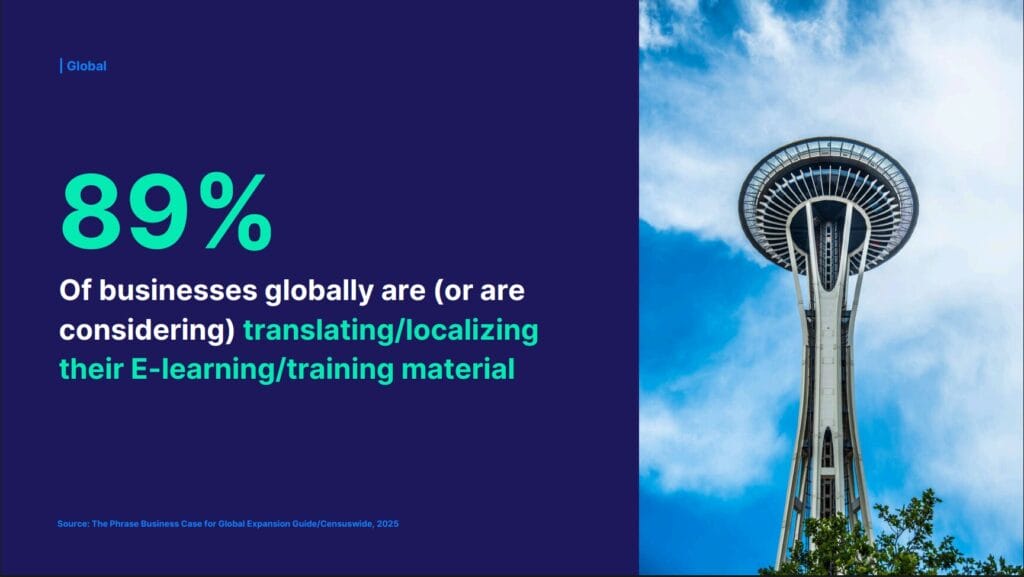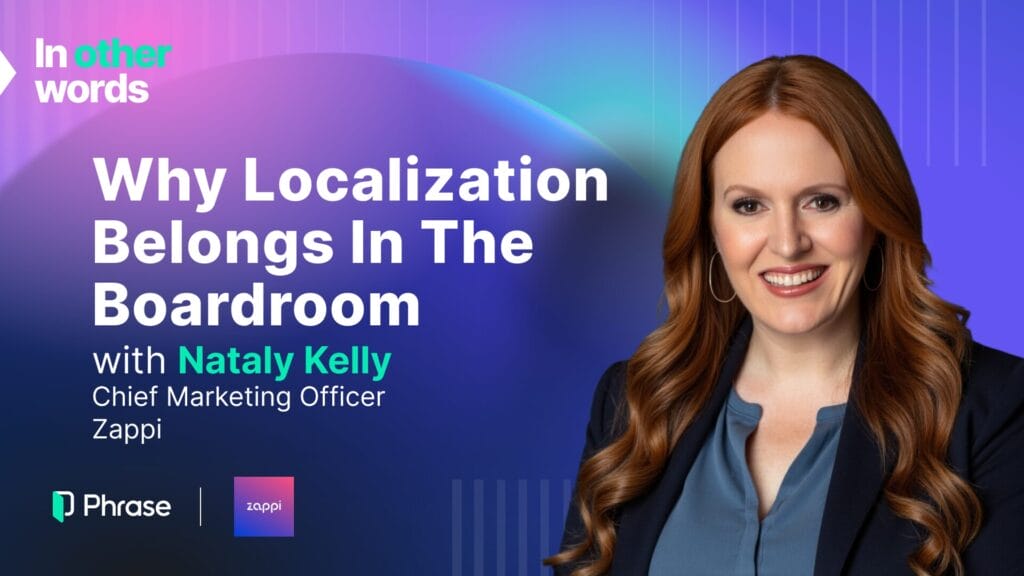As the global education landscape evolves, so too must the tools that power it. From online universities to corporate training programs and educational publishers, the demand for multilingual content has exploded, fueled by digital transformation, global expansion, and the growing expectation for inclusive, personalized learning experiences.
In response, many organizations are taking a fresh look at how they adapt their educational content. Not just to translate it, but to ensure it resonates with learners in every market.
For many years, organizations relied on traditional translation systems (Trados, XTM etc.)to manage multilingual content.
These tools were built for a slower, document-heavy world. But education teams today face very different realities: courses are built from interactive modules, video, and assessments; content is updated frequently; and compliance requirements vary from region to region.
Older systems struggle to keep up with this pace. What’s needed now are platforms that support faster, more collaborative, and automated workflows—ones designed for the dynamic nature of modern e-learning.
What’s emerging is a new standard for translating and localizing educational content, built on cloud-native platforms, AI-powered workflows, and scalable collaboration across teams and geographies. And the goal isn’t to discard what’s already working, but to evolve. To move from traditional translation management toward a smarter, more flexible strategy that supports rapid growth and deeper learner engagement.
In this post, we’ll explore the trends driving this shift, highlight real-world examples of education companies adapting successfully, and examine how forward-thinking teams are reimagining localization as a strategic enabler for global learning delivery.
Why AI matters, and why now
Artificial intelligence is becoming a foundational part of how content is created, delivered, and localized in education. According to recent projections, the global AI-in-education market is projected to grow from USD 4.7 Billion in 2024 to USD 26.43 Billion by 2032, growing at a compound annual rate of almost 40%. More than 47% of educational institutions worldwide are actively using AI technologies daily to support teaching and content delivery.
Much of this growth comes from AI’s ability to improve educational outcomes. Adaptive learning platforms, virtual tutoring assistants, and personalized assessment systems are producing measurable results. Reports show performance improvements of 30–50%, with retention rates up by 20–30% in AI-assisted environments.
The same technology is transforming how multilingual educational content is produced. AI-powered translation platforms can now deliver 60–70% faster turnaround than traditional workflows. For institutions with high content velocity, this translates into cost reductions of up to 60% for large-scale projects.
AI is changing the economics of how educational content is scaled and delivered across global markets. Content can be made available across markets faster, reduce manual work, and maintain quality in ways that were previously unattainable. For education providers looking to grow, adapt, or expand globally, adopting AI-powered localization has become a strategic imperative.
2. Educational content is evolving at pace
Modern e-learning programs are built around a wide variety of formats. Instructional content now includes interactive modules, video lectures, formative assessments, localized dashboards, and mobile-first experiences. These materials are often updated regularly to reflect curriculum changes, regional standards, and learner behavior.
This shift has increased both the volume and frequency of content updates. Institutions are expected to release content across multiple platforms and markets without delay. As a result, localization now needs to be part of a continuous publishing workflow, rather than an add-on at the end of the creation process.
Legacy workflows make this difficult. Offline translation packages, fragmented file handoffs, and version-control issues introduce delays and inconsistencies. These challenges are especially visible in multilingual projects involving several teams and markets.
To support ongoing delivery, educational teams require localization environments that are connected to their core systems, allow contributors to work simultaneously, and ensure updates move efficiently from source to deployment. In this environment, the focus shifts to workflows that enable coordination, consistency, and adaptability at scale.

3. Localization platforms must evolve with content demands
The systems used to manage localization have not always kept pace with the way educational content is now produced and distributed. Many platforms were originally designed to handle document-based translation, often in linear workflows with limited stakeholder access.
Today’s content environments are more connected. Learning materials are created, updated, and published across multiple systems and teams. To support this, education providers need localization platforms that can integrate into that flow rather than interrupt it.
Modern teams benefit from:
- Cloud-native collaboration, where linguists, reviewers, and subject-matter experts can work in parallel.
- Direct integrations with content platforms like LMSs, CMSs, and design tools to reduce manual work and preserve formatting.
- AI-driven automation, such as pre-translation suggestions, automatic task routing, and workflow triggers that align with release schedules.
These capabilities support localization as part of a living content ecosystem. Phrase, for example, is designed to meet these requirements through a flexible cloud platform that can support both structured content and UI strings, handle complex stakeholder collaboration, and integrate machine translation and review processes with minimal overhead.
Teams managing education content at scale are moving toward solutions like Phrase to simplify operations, reduce time-to-publish, and ensure that localization remains aligned with broader content strategy and infrastructure.
4. Evidence from the field: momentum behind migration
Organizations across the education sector are rethinking how they approach localization. Their goals are often the same: improve speed, manage cost, and ensure content reaches learners in the right format and language without compromising quality.
For example, Deliveroo adopted the Phrase Localization Platform to support its international growth. By centralizing workflows and automating key tasks, Deliveroo reduced project timelines by three to four days, saved 40% of the time typically spent by managers and developers, and scaled into more than ten markets with consistent quality. The result was not only faster market entry, but also improved customer satisfaction across regions.
Elsewhere, education-focused enterprises reported cost savings of up to 60% by combining AI-powered translation with targeted human review. In these workflows, machine translation handles repetitive or high-volume content, while reviewers focus on subject-specific or compliance-sensitive material. This approach shortened launch cycles and made it easier to coordinate multi-market releases (Single Grain).
These outcomes reflect a broader shift. Educational content teams are working with greater urgency and flexibility than many traditional localization systems were built to support.
Cloud-native platforms like Phrase Studio are increasingly chosen for their ability to adapt to that pace, offering integrated workflows, automation features, and visibility across all stages of content development.
5. Human and AI collaboration in localization workflows
As educational organizations scale their content, the challenge is no longer whether automation can help, but how to apply it responsibly and effectively. In the context of localization, this means using AI where it creates efficiency, while reserving human expertise for content that requires context, precision, and cultural fluency.
This hybrid approach has become the new standard for high-performing teams:
- AI-powered translation systems now handle the bulk of high-volume tasks such as baseline translations, caption generation, or content repetition across similar modules.
- Human reviewers focus their attention on complex material—like curriculum-related text, culturally sensitive phrasing, or assessments with specific tone and intent requirements.
- Quality assurance tools, such as validated prompts, linguistic scoring models, and context-aware review routing, help teams maintain consistency and reduce unnecessary effort.
Phrase is built around this model. Features such as Phrase Quality Performance Score (Phrase QPS) and intelligent content routing allow teams to apply linguistic resources where they’re most valuable. Low-risk content can move through automated pipelines, while high-priority material is flagged for in-depth review. These workflows are customizable by project type, content category, or target market.
In a pilot by a global software company, this workflow cut human review volume in half—a 50% reduction in human review effort—allowing much of the content to skip manual oversight entirely.
This model supports quality at scale without overwhelming reviewers, and it enables teams to meet increasingly tight timelines without compromising the educational integrity of their content.
Why regional accuracy matters in education localization
As more institutions scale content internationally, it becomes clear that “one-size-fits-all” translation simply doesn’t work, especially in education. Tone, terminology, and cultural alignment matter not just for user experience, but for educational credibility and regulatory compliance. Nowhere is this more evident than in large multilingual regions like Latin America, where language variation can dramatically influence learning outcomes.
Spanish is one of the most widely spoken languages in the world, but treating it as a monolith quickly creates problems in educational content. In regions like Mexico, linguistic expectations differ in tone, structure, and terminology, especially within formal learning environments. A generalized translation model often fails to capture these nuances, which can undermine clarity, learner trust, and compliance with local standards.
Educational organizations localizing for Spanish-speaking markets in Latin America increasingly require domain-aware AI translation. This means working with systems that are tuned for regional tone, specialized vocabulary, and curriculum-specific language.
Key requirements include:
- Tailored machine translation output, optimized to reflect Mexican Spanish grammar and educational tone. This often involves using fine-tuned language models or prompt-based guidance.
- Centralized termbases and linguistic assets, so that terminology for academic subjects, government-aligned standards, and institution-specific language remains consistent across courses and updates.
- Support for rapid updates, particularly where learning content is subject to seasonal or policy-driven changes. Platforms that require offline file management or manual packaging can delay this process significantly.
Phrase addresses these needs through several capabilities:
- Support for Custom AI, allowing education teams to build MT configurations based on regional usage and historical content.
- Integrated term and style management tools, ensuring consistency across disciplines and semesters.
- Real-time collaboration features, allowing content updates to be made and approved without re-exporting files or disrupting LMS publishing cycles.
Organizations using Phrase to support Spanish (Mexico) have reported significantly lower review burden. In one case, in-house reviewers in Mexico needed only minor corrections after machine translation, with most feedback centered on institutional preferences rather than outright errors.
As education providers expand into Spanish-speaking markets or scale content across Latin America, the ability to deliver regionally accurate and pedagogically appropriate content becomes a critical part of the learner experience.
7. Strategic impact: beyond translation toward growth
Modern localization is not only a content operation, it’s a strategic lever for growth. For education providers expanding into new regions, delivering consistent and culturally aligned content can directly influence learner engagement, market reach, and operational efficiency.
Several clear benefits are emerging from institutions that have embraced scalable, AI-powered localization workflows:
- Accelerated market entry. By localizing courseware, assessments, and learner interfaces in parallel across markets, education teams can launch regionally tailored offerings without staggered timelines or bottlenecks.
- Improved learner outcomes. Consistent tone, accurate subject-specific terminology, and cultural relevance contribute to higher levels of trust and comprehension among students, particularly in primary and secondary education settings.
- Cost and time savings. Education organizations using hybrid localization models report cost reductions of 40–60%, alongside significantly shortened production cycles
- Greater control and oversight. Cloud-based platforms with built-in quality metrics, workflow visibility, and user-based permissions allow education leaders to monitor performance, assess ROI, and manage localization as part of a broader content strategy.
Phrase supports these goals through features such as automated task routing, quality scoring (Phrase QPS), and real-time tracking of translation throughput and review feedback. Education teams using Phrase can manage content localization in step with curriculum updates, enrollment cycles, and institutional timelines.
By shifting localization from a back-office function to a strategic enabler, education providers are positioning themselves to scale confidently and serve diverse learning communities with relevance and speed.
8. Rethinking e-learning localization as a growth-ready discipline
For educational institutions and content providers, localization has traditionally been viewed as a downstream process. One that’s necessary for access, but rarely prioritized as a driver of performance or scale. That mindset is changing. As course materials become more interactive, multilingual, and market-specific, localization now plays a direct role in learner engagement, platform consistency, and global expansion.
This evolution doesn’t require abandoning legacy systems overnight. What it does require is a shift in approach: away from rigid workflows and toward modular, connected systems that are built to support the pace and complexity of modern education.
AI and automation are critical to making this shift sustainable. Used thoughtfully, these technologies can extend human capacity, reduce operational friction, and ensure that quality doesn’t get lost as content scales. And when paired with cloud-native platforms, they make localization easier to manage, faster to deliver, and more deeply embedded in the content lifecycle.
Platforms like Phrase are helping education providers scale high-quality learning content with the speed, precision, and flexibility, while still preserving the trust and nuance that education demands.
For e-learning leaders, now is the time to reframe localization not as a cost to manage, but as a capability to grow. The infrastructure exists. The benefits are clear. The teams already creating global-ready content deserve systems that are just as ready to support them.
Explore how Phrase can help transform your educational content velocity
Let’s chat, or share this with your tech, content, or learning operations teams for alignment and next steps.






